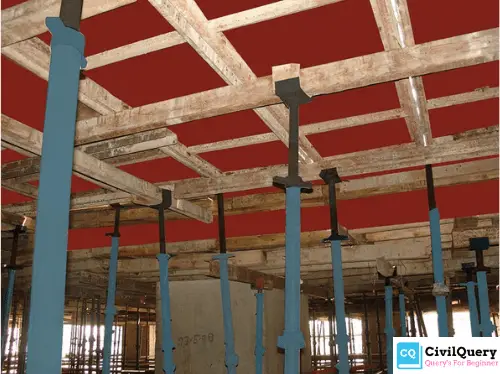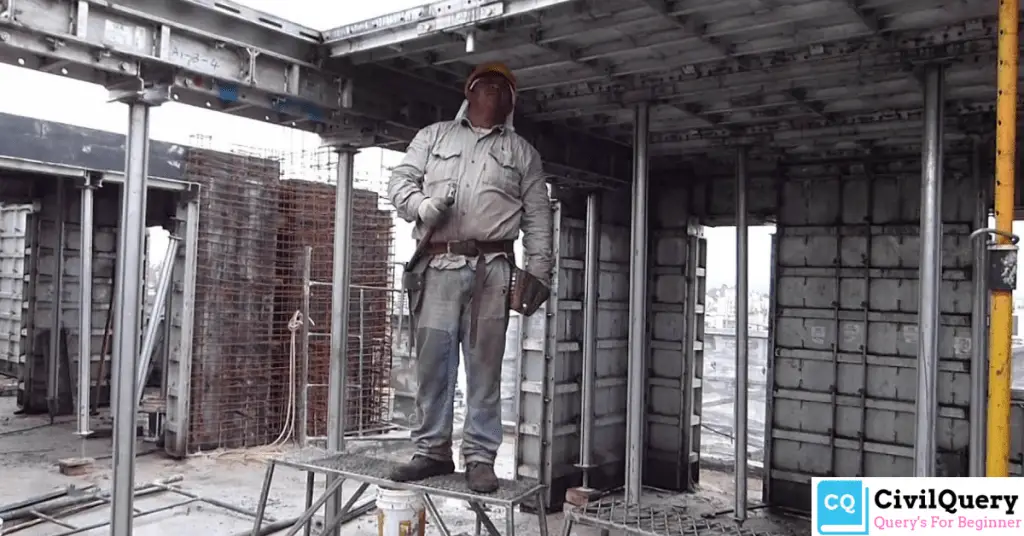What is formwork?
Formwork is the mould which is used in construction for giving desire structural shape by pouring concrete in the mold. In simple word, formwork is a mold to cast concrete member in different shapes and sizes. There are many different types of Formwork available in market
Shuttering is a synonym term of Formwork. In many countries, people use word Shuttering instead of formwork.
Contents
Types of Formwork.
- Timber formwork
- Plywood formwork
- Steel Formwork
- Aluminum Formwork
Timber Formwork

Timber Formwork should comply with the following requirement:
- It should be well Seasoned
- It should be light in weight
- Timber should be easily workable with nails without splitting
- It should free from loose knots.
The timber used for formwork should have smooth and even surface on all the sides, which comes in direct contact with concrete.
Timber formwork is used in a small quantity of concrete work.
Read Also: Difference Between Shallow Foundation and Deep Foundation
Standard Size of Timber for Formwork
| Shuttering for Slab, beam, column, and beam bottom | 25 mm to 40mm thick |
| Joints, Ledges | 50 mm X 70 mm to 50 mm X 150 mm |
| Posts | 75 mm X 100 mm to 100 mm X 100 mm |
Advantages of Timber Formwork
- Timber can be cut in any desired size easily.
- Timber is light in weight so it can be handled easily.
- Timber is a good thermal resistance so, it prevents concrete damage in colder regions.
- Construction method to this type of Formwork is easy to understand, so it doesn’t require skilled labor.
Disadvantages of Timber Formwork
- Dry timber absorbs water from concrete, which results in the reduction of concrete strength.
- Timber formwork can be reused only for 5 to 6 times
- Timber with more moisture content (<= 20%), wet concrete will shrink and leakage of Cement slurry.
Read Also: Types of Deep Foundation and Its use in Construction
Plywood Formwork (Conventional Formwork)

Plywood for concrete formwork is a BWP (Boiling waterproof) grade plywood, it is a preservative-treated and especially suited for use in shuttering and formwork. Plywood formwork is very economic as it can be put to repeated use, depending upon the care taken during erection and dismantling.
The main advantage of using plywood shuttering is, it is durable under alternate wetting and drying conditions, Plywood has a hard surface and it possesses adequate strength to withstand a load of concrete and the forces caused by pouring of concrete and vibrations.
Standard Size of plywoods are as follow
| Plywood Size in Feet | Plywood Size in MM |
| 8’ X 4” | 2440 X 1220 |
| 8’ X 3’ | 2440 X 920 |
| 7’ X 4’ | 2140 X 1220 |
| 7’ X 3’ | 2140 X 920 |
| 6’ X 4’ | 1830 X 1220 |
| 6’ X 3’ | 1830 X 920 |
The standard size of plywood measures in millimeter. Various thickness of plywood shown in the table below.
| Plywood Grade | Thickness in mm |
| MR Grade Plywood (Moisture Resistant) | 3, 4, 6, 8, 12, 15, 18, 21, 25 mm |
| BWR Grade Plywood (Boiling Water Resistant) and FR Grade (Fire Resistant) | 4, 6, 9, 12, 16, 19, 2 5 mm |
Advantages of Plywood Formwork (Conventional Formwork)
- Plywood can be easily be cut in the required size.
- Plywood is strong, durable and light in weight.
- Plywood provides smooth finish concrete surface.
- Plywood makes formwork quicker and easier.
Compared to Timber Formwork plywood gives more repetition.
Read Also: What is Shallow Foundation? | Types of Shallow Foundation
Steel Formwork

Steel formwork is Consist of panel fabricated out of thin Steel Plates. Steel Formwork is popular nowadays because it gives a long life span and it gives better repetition. The Steel Panel units can be fixed together using suitable Clamp, Nut, and Bolts. Steel Panel can be fabricated in any modular shape or size. Mostly this type of Formwork used for Circular and Curved structure.
Advantages of Steel Formwork
- Steel Panels are stronger, durable and have longer life Span
- Steel Panels can be installed and dismantled easily with great speed.
- It is cost-effective if construction is going on in large quantity.
- Steel panels do not absorb water or moisture from Concrete.
- This type of Formwork doesn’t shrink or warp.
- The quality of the concrete surface by steel formworks is smooth, and it doesn’t require any further treatment.
Disadvantages of Steel Formwork
- It is very costly compared to Plywood
- The steel panel is very heavy in weight, to lift the panel it requires lifting equipment.
- It is limited to size and shape.
Aluminum Formwork

Aluminum Formwork | Types of Formwork
Aluminum formwork is similar to Steel formwork. This type of formwork is lighter than Steel formwork, due to the low density of the Aluminium its lighter than steel. This type of formwork is economical if a large number of times repetitions are made in Construction.
Advantages of Aluminium Formwork
- Aluminum Formwork increases the speed of construction and saves time and labor
- It gives a better and smooth finish surface.
- Aluminum formwork can be reused up to 250 times.
- It is cost-effective if a large number of symmetrical structures are to be built.
Disadvantages of Aluminium Formwork
- The initial cost is high because of aluminum formworks more expensive.
- This type of formwork is cost-effective if it used in a symmetrical type of structure.
- Initially, it takes time to set-up.
- For this type of formwork, Skilled labors are required for alignment and maintenance purpose.
- Holes caused during formwork by wall tie should be grouted properly, or else there will be a leakage problem in the
future .



My husband and I are building our dream house! I didn’t know that plywood was strong and lightweight, so it provides a strong concrete-looking finish. I’ll keep that in mind as I look for the right contractor for our foundation. http://superformmt.com/
Generally, to know about formwork what it is and what it is used for then you need to undergo its type as what are its type and why it is used in construction line although there are four type of formwork available in market which are timber, aluminum, plywood and lastly steel formwork but as from my view Aluminium Formwork System is stronger than that of other formwork system.
Thank u for sharing inspiration your article
Form Work | Good Requirements of Form Work..!
The construction industry worldwide has advanced with the advent of modern
technology. The Architects with the help of computer programs design eye-catching structures. The construction company’s use formwork in construction
to create huge projects.
Formwork is all about pouring concrete from above into the molds. The
concrete becomes hard in no time and one gets hard and long-lasting
structure! As modern day construction is lauded by all. The formwork
technology has created marvels!
There are many different formworks used for construction, right from steel
formwork to Aluminium, Plastic, timber, etc. It all depends on the type of
construction suiting to one’s budget!
Construction materials used today are of a robust quality and safer and practical
structures are constructed using formwork technology.